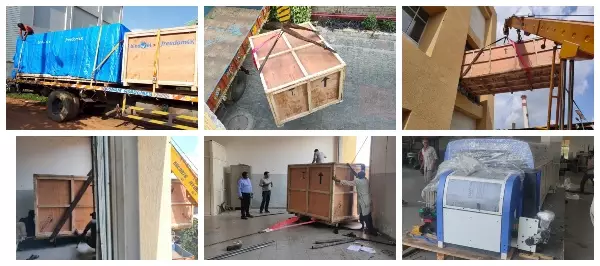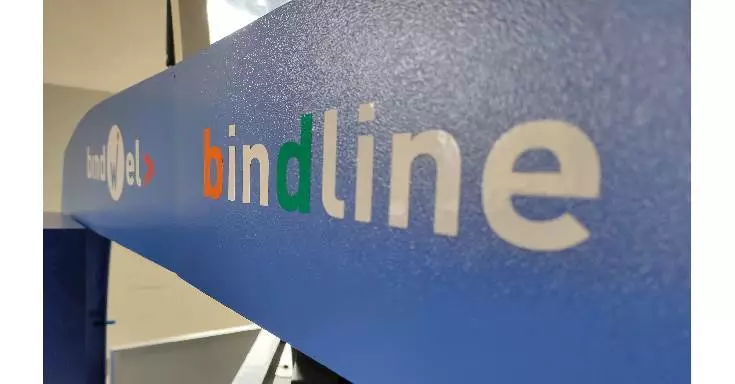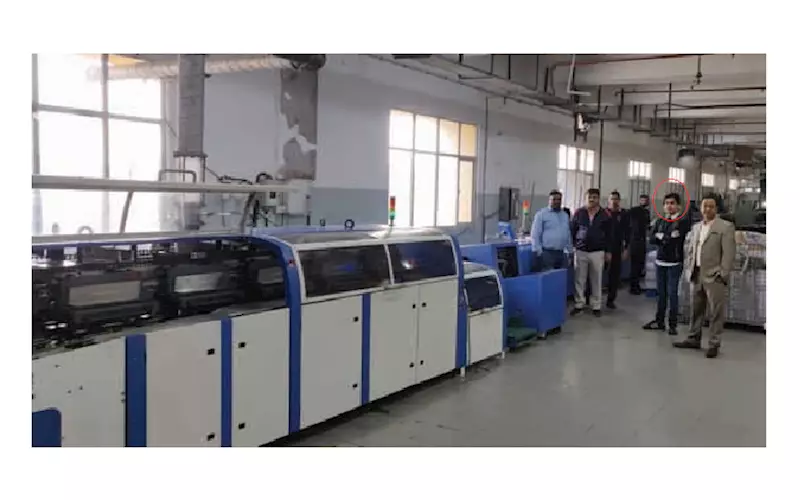Arihant: Meerut’s printer-publisher is India’s pride
Arihant: Meerut’s printer Parvesh Jain at Arihant, shares the highlights of the past 23 years with Ramu Ramanathan about how the firm is bullish about books
01 Mar 2021 | By PrintWeek Team
Ramu Ramanathan (RR): Let’s begin with the genesis of Arihant’s journey in the heart of the publishing hub of Meerut, which is well known for educational publishing…
Parvesh Jain (PJ): Arihant was established by my two brothers and I in 1997. While I oversee the complete printing operation, Deepesh and Reetesh look after content development and sales and finance respectively.
RR: Arihant is probably one of the few publishers in the country, which publishes books in almost all the segments of education…
PJ: Since our inception with a set of books for IIT JEE in 1997, Arihant currently publishes more than 3,000 titles for engineering, medical, competitive entrances, school curriculum, ITI, polytechnic and government recruitment examinations.
RR: What has been the greatest achievement for Arihant thus far?
PJ: Every year since 1997, Arihant has managed to venture into new segments in educational publishing. Now, in a short period, we spread our branches all across the country. During that time, printing was outsourced despite having our own book printing press in Meerut.
RR: When did you think of consolidating the printing of your publications in different locations?
PJ: In 2014, we moved to a 12-acre facility, which housed a factory that could compete with the biggest of book-printers in India. All the capacity that we built up is being used for our publications.
RR: Arihant has invested in multiple webs. How did you plan your binding to cope with the bottleneck in post-press?
PJ: The binding in our press was initially dominated by the single- and six-clamp binders, and an occasional offline high speed machine. It took some time to graduate to complete in-line solutions, as the workflow, including processing and movement of material, is very crucial.
RR: That is when you decided to invest heavily in post-press…
PJ: Over the years, the offline binders were replaced with pre-owned European inline binders from Muller Martini and Kolbus. The binding facility now includes an Accoro A5, A7, Kolbus KM 470, complete with gatherers and inline trimmers.

RR: Any machinery from Indian manufacturers on the post-press shop floor?
PJ: Recently, an Impel-Welbound Bindwel Bindline consisting of a 16-station Signa gatherer and a 12-clamp Freedom 4K binder were added to the above armoury.
RR: How did the shop floor workers in the post-press department respond to the new machinery?
PJ: Pretty well, judging by the fact that so far, we have produced 10 lakhs books in month since the installation. My team is happy that we made this decision. The Impel-Welbound director Anil Kumar visits us regularly to understand any challenges that we are facing and provides immediate solution.
RR: Chasing low-priced manpower has often been touted as a dangerous practice by experts. What is your view?
PJ: The more handling one has, between printing and packing plus loading on to trucks, it creates more wastage. The concept of low-cost manpower does not end up being cost effective. This is owing to the fact that the biggest cost in a bindery is manpower. And this is directly related to wastage.
RR: This brings us to: inline vs offline. What are the operational benefits?
PJ: By linking the process of gathering to finishing the book, we are able to ensure that the mistakes are near-zero, books do not get smeared, turnarounds happen faster, lesser energy is consumed – all of which lead to a better quality at predictable speeds and lower costs.
THE IMPEL-WELBOUND PARTNERSHIP
Before going in-house with our postpress machinery, all of our jobs were outsourced at shop floors, which had Welbound machines. For us, it meant a natural progression of an association of more than two decades. When Impel decided to move away from its partners in Kerala, to set up a manufacturing in Bengaluru, we were one of the early buyers of machines made in Bengaluru. Welbound Technical Services, its sister concern handled all our installations of imported European binding machines.
RR: How do you want to reduce binding time for paperbacks without compromising quality?
PJ: Product runs are coming down, even in educational publishing while the number of titles keeps increasing. This means a binder should be able to change over from a given setting to another as quickly as possible. With new machines and affordable automation, this is possible.
RR: How often do you review your factory operations?
PJ: We have operational reviews on a regular basis. As we handle a wide range of markets the complexities related to paper, sizes, book thickness, runs and turnaround times are huge. We need to be very agile in our planning and operations.
RR: Agile is good. But how do you deal with the growth of complexities that accompany the company growth?
PJ: There are quarterly and annual management reviews, that discuss everything from the year to date performance, forecast, uncertainties (as we face now), and opportunities. Such reviews help us conclude on the top issues and the top opportunities and then we plan the steps needed for achieving the optimal results.
RR: Every time you decide to scale up the operations, there is a cost cycle that you go through…
PJ: Despite having a large area for expansion, space is something that needs absolute focus as costs simply follow the increase in it. Year-on-year, if we can produce the same quantity of books at equal or better quality, while consuming less space, energy and manpower, then we have won the game.
RR: And how have you managed to achieve that?
PJ: From the many ways that we had thought of, one of it was to invest in a Bindwel Bindline, which consumes 35% less space and energy, while delivering the same quantity of books compared to the European binders that we have.
RR: Interesting. As a publisher, how do you define long runs/short runs?
PJ: We are definitely past the era of printing millions of books of the same title. Only government textbooks have print runs, which notch up in lakhs. While we may have some texts running into such numbers, the runs get reduced by division as the cover could be different and some portions are customised. In education, we consider 5,000 as short runs and 50,000 as long runs.
MEERUT – AT A GLANCE
The size and stature of the Meerut book industry…
Meerut can be called as the Daryaganj of Uttar Pradesh. After New Delhi, Meerut must be the largest publishing printing hub in the country, though Meerut is more popular for educational publishing now. Once upon a time it used to be the pulp fiction capital of the country.
One virtue about the Meerut book industry…
The city used to be a hub for publishers, writers and artists of Hindi pulp fiction since its inception. Many of these publishers did printing in New Delhi due to the availability of a huge number of printers. Although printing would be in New Delhi, binding used to happen closer to home. At that time, folding was done manually at homes, before they are brought to a hall where gathering and perfect binding would happen.
One inside info about Meerut …
The fact that Meerut is the most cost-efficient converter of paper into books in India. Many leading integrated print houses in the country have approached publishers in Meerut for print jobs in the past, and have left with the information of our unbelievable cost of conversion.
Impact of GST on the printing and publishing book industry in Meerut…
GST was not good for the publishing industry, as all the increase associated to that ended with us, publishers. The consumer is not aware of the GST as books are not taxed. The distributer network was not willing to foot the cost. So, in most cases, the publishing industry ended up absorbing the same.
RR: With schools and colleges remaining shut during the pandemic, how much has it impacted Arihant?
PJ: Business had declined by 40%. However, we expect this segment will be quickly up and running, as we have the schools reopening now.
RR: As per market reports, we are hearing that unit sales of books in the first half of 2020 is not all doom and gloom. Is there any uptick of demand? Your view…
PJ: Quite true. Except school textbooks, the remaining segments have already picked up steam. And as we hear from the market, in some states such as West Bengal, even school textbooks are being printed.
RR: On the other hand, a world which has virtual classrooms and growing unemployment could lead to new trends in publishing. What is the Arihant view on this?
PJ: Our view is that online will coexist with classrooms. Content is the king and presentation is its queen. So be it textbooks or virtual classroom content, you have to be ahead of the curve. There are huge business opportunities for print, even in online education.

RR: Many publishers have dabbled in to crossover (multimedia) content, but these are generally on the backburner. With the state of education right now, is Arihant bootstrapping some of these solutions?
PJ: It is like the physical retail waking up to the new world of eCommerce. Same product is sold, but the rules are different. Once you understand, then bridging the gap will become easier.
RR: Along with K-12, there would be a growing audience for skill development content. Are publishers addressing them?
PJ: We have lot of content related to competitive examinations addressing employment. They cover basic subjects and special topics related to certain skills.
RR: What is the one tough lesson to learn from this pandemic?
PJ: Cost cutting. This is not merely on paper, but also in practice. We have no long-term plans for the future; at least for the time being.
RR: I see. Let me conclude this interview with my favourite question. What is the one book project, which you produced that was very difficult?
PJ: A book called General Studies Manual, which was a 2.75-inch back cut job produced on the Impel-Welbound WB@2500 six-clamp perfect binding machine.














 See All
See All